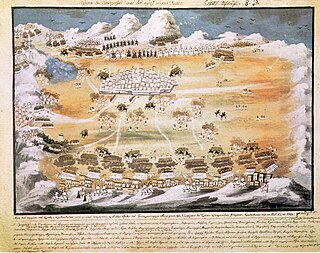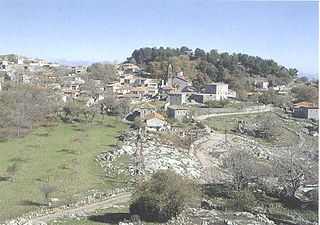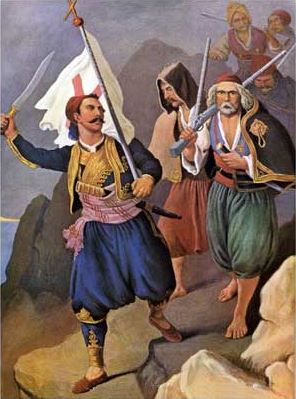
The Greek War of Independence, also known as the Greek Revolution or the Greek Revolution of 1821, was a successful war of independence by Greek revolutionaries against the Ottoman Empire between 1821 and 1829. In 1826, the Greeks were assisted by the British Empire, Kingdom of France, and the Russian Empire, while the Ottomans were aided by their vassals, especially by the Eyalet of Egypt. The war led to the formation of modern Greece, which would be expanded to its modern size in later years. The revolution is celebrated by Greeks around the world as independence day on 25 March.

Elis also known as Ellis or Ilia is a historic region in the western part of the Peloponnese peninsula of Greece. It is administered as a regional unit of the modern region of Western Greece. Its capital is Pyrgos. Until 2011 it was Elis Prefecture, covering the same territory.

The Mani Peninsula, also long known by its medieval name Maina or Maïna, is a geographical and cultural region in the Peloponnese of Southern Greece and home to the Maniots, who claim descent from the ancient Spartans. The capital city of Mani is Areopoli. Mani is the central of three peninsulas which extend southwards from the Peloponnese. To the east is the Laconian Gulf, to the west the Messenian Gulf. The Mani peninsula forms a continuation of the Taygetos mountain range, the western spine of the Peloponnese.

Kalamata is the second most populous city of the Peloponnese peninsula in southern Greece after Patras, and the largest city of the homonymous administrative region. As the capital and chief port of the Messenia regional unit, it lies along the Nedon River at the head of the Messenian Gulf.

Grigorios Dimitrios Dikaios-Flessas, popularly known as Papaflessas (Παπαφλέσσας), was a Greek priest and government official who became one of the most influential figures during the Greek War of Independence. The prefix papa- (παπα-) in the name Papaflessas indicates his status as a cleric since the word means 'priest' in Greek. He was appointed Archimandrite in 1819. He served as Minister of Internal Affairs and Chief of Police in the government of Alexander Mavrokordatos. Papaflessas was killed during the Battle of Maniaki on May 20, 1825, fighting against the forces of Ibrahim Pasha at Maniaki, Messinia.

Petros Mavromichalis, also known as Petrobey, was a Greek general and politician who played a major role in the lead-up and during the Greek War of Independence. Before the war, he served as the Bey of Mani. His family had a long history of revolts against the Ottoman Empire, which ruled most of what is now Greece. His grandfather Georgios and his father Pierros were among the leaders of the Orlov Revolt.

The Battle of Vromopigada was fought between the Ottoman Turks and the Maniots of Mani in 1770. The location of the battle was in a plain between the two towns of Skoutari and Parasyros. The battle ended in a Greek victory.

The Ottoman–Egyptian invasion of Mani was a campaign during the Greek War of Independence that consisted of three battles. The Maniots fought against a combined Egyptian and Ottoman army under the command of Ibrahim Pasha of Egypt.

The Maniots or Maniates are an ethnic Greek subgroup that traditionally inhabit the Mani Peninsula; located in western Laconia and eastern Messenia, in the southern Peloponnese, Greece. They were also formerly known as Mainotes, and the peninsula as Maina.

The First National Assembly of Epidaurus was the first meeting of the Greek National Assembly, a national representative political gathering of the Greek revolutionaries.

The siege of Tripolitsa or fall of Tripolitsa, also known as the Tripolitsa massacre, was an early victory of the revolutionary Greek forces in the summer of 1821 during the Greek War of Independence, which had begun earlier that year, against the Ottoman Empire. Tripolitsa was an important target, because it was the administrative center of the Ottomans in the Peloponnese.

The Mavromichalis family is a Greek family from Mani Peninsula, which played a major role in modern Greek history.
The Battle of Valtetsi was fought on 24 May (N.S.), 1821 in Valtetsi between the Ottoman army and Greek revolutionaries.

Kyriakoulis Mavromichalis was a Greek revolutionary who fought in the Greek War of Independence.

Valtetsi is a village in the municipal unit of Valtetsi, Arcadia, Greece. It is located in the Central Peloponessus in what is called Ορεινή Αρκαδία at a distance of 12 km west of Tripoli and an altitude of 1,050 m. It is a small plain terrain surrounded by four hills: Chomatovouni, Mylos, Katsikeika and Dovrouleika. It is considered a traditional settlement.
The Senate of the entire People of the Peloponnese provinces, commonly known as the Peloponnesian Senate, was a provisional regime that existed in the Peloponnese during the early stages of the Greek War of Independence.
Pieros Voidis Mavromichalis was a military leader of the Greek Revolution of 1821. He was born in Mavrovouni of Mani and he was killed in action on 20 May 1825, during the battle of Maniaki between Greek revolutionaries and the Egyptian forces of Ibrahim Pasha.

Anagnostaras was a Greek revolutionary, a leading member of the Filiki Etaireia, and later a general and War Minister of the Greek War of Independence. Anagnostaras is a nom de guerre, he was born as Christos Papageorgiou and signed as Anagnostis Papageorgiou .
The Papatsonis family is a Greek family that participated in the Greek War of Independence and the history of modern Greece.
Panagiotis Michanidis was a leader and fighter of the Greek Revolution of 1821 from Maroneia, Thrace.














